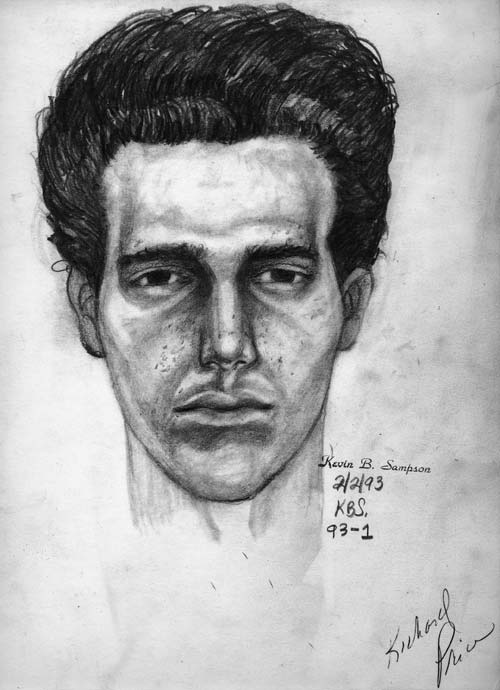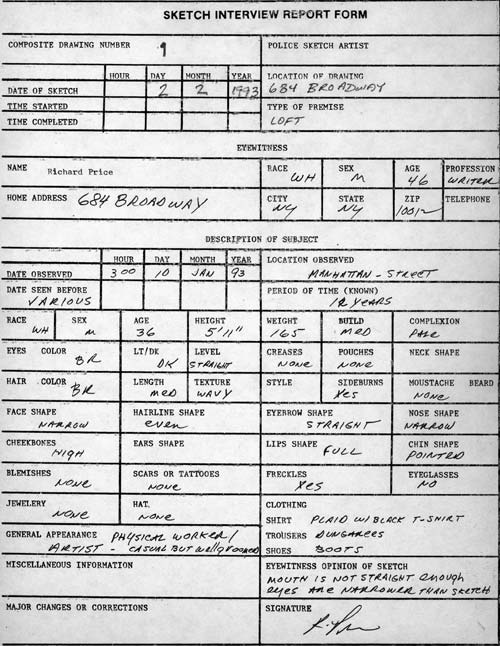Police Composite Drawings
(1992 – 1994)
Eyewitness: RICHARD PRICE
While riding the subway to my studio, I noticed a discarded newspaper on the seat opposite. The open page revealed a sketch of a subject being sought by the police. How does this system of drawing work to successfully identify the subject? I had to find out more…
Stephen Spretnjak: concept, organizer, and "target subject".
Composite Artist: Officer Kevin Sampson of the New Jersey State Police Department
Eyewitnesses: Richard Price, Judith Linhares, Saul Ostrow, Karin Davie, Devin Golden, Greg Drassler, George Minot, Ann Carter, Marianne Stikas, Joan Stennick, Dennis Elliott, Jeff Smith, Dona Nelson, Steve Keister, Marcia Scanlon and Lawrence Lockridge, Lochi Sampson, and Officer Kevin Sampson.
Standard Police Format – pencil on paper 9 X 12 inches each.
17 Composite Sketches – 18 Report Forms (one dual sketch).
The success of the work would depend on following the methods developed and used by law enforcement. In order to organize this conceptual work, I selected myself to be the “ "subject" or "target person". Within this framework, a face-to-face meeting with a sketch artist would jeopardize the integrity of the work. All conversations would take place by telephone.
Officer Kevin Sampson was regarded as one of the best in the composite field. Over a 20-year career, his drawings (published in the local media or handed to detectives) had led to a very high percentage ratio of identification and apprehension. He had developed a distinct style that aided in the development of the character through the use of subtle shading and attention to the rendering of hair. His composite style was more appealing to me than the “cartoon-like” renderings of other police artists. Over the course of several telephone conversations, he enthusiastically provided information and insights into the system.
Sampson's background involved studying with George Homa, developer of the system and author of "The Police Composite Sketch Artist" manual. This system uses only that which is necessary to identify, apprehend, and stand up in a court of law. It arranges simple shapes that create combined relationships and lead to more highly regarded representations. The technique relies on a complete knowledge of the bone structure of the skull and how the muscles are attached … "If the subject is described as having a narrow face … the temples will pinch … cheeks come forward … eyes narrow and slant upward … the forehead hairline forms a widow’s peak …". Drawing skills and technique are not the main element used in creating the subject’s appearance. The key to success follows the sketch artist’s ability to communicate with and gather information from the eyewitness. The sketch artist does not begin drawing until he "visualizes" the subject. Officer Sampson had the ability to put the eyewitness at ease then elicite the necessary physical details through memory recall.
I began to make a list of eyewitnesses. My selections would be based on period of time known, period since the last observation, and the strength of the encounter circumstances. I would develop a range from frequent sightings, brief encounters, friends visiting who hadn’t seen me in years, a duel-couple sketch, and a circumstance with an unknown person. Those considered had strong observational skills: visual artists, writers, business associates, and a hair stylist.
I began to schedule the meetings. Officer Sampson met the eyewitness, produced the sketch, left the sketch on site, and then telephoned upon leaving. I would immediately place a call to the eyewitness and fill out the questions listed on my Police Report Form. Afterward, I would arrange to collect the composite. A total of 17 sketches were completed over the two-year period. I asked Officer Sampson to draw the last from his memory of the others. Notes: Each drawing contains a key feature that the eyewitness recalled as unique. This vivid feature becomes their descriptive starting point. Such communicates from the overall facial structure to someone out in the world. It functions as the element that causes one to say, "I know that person." Because the sketches reflect the subject over a long period of time, we had a built-in variety of hair length. The most common practice used to avoid identification is to alter one’s hair (cutting, growing, dying, shaving, etc.). The sketch artist did not need to draw time-elapsed hair change transparencies.

